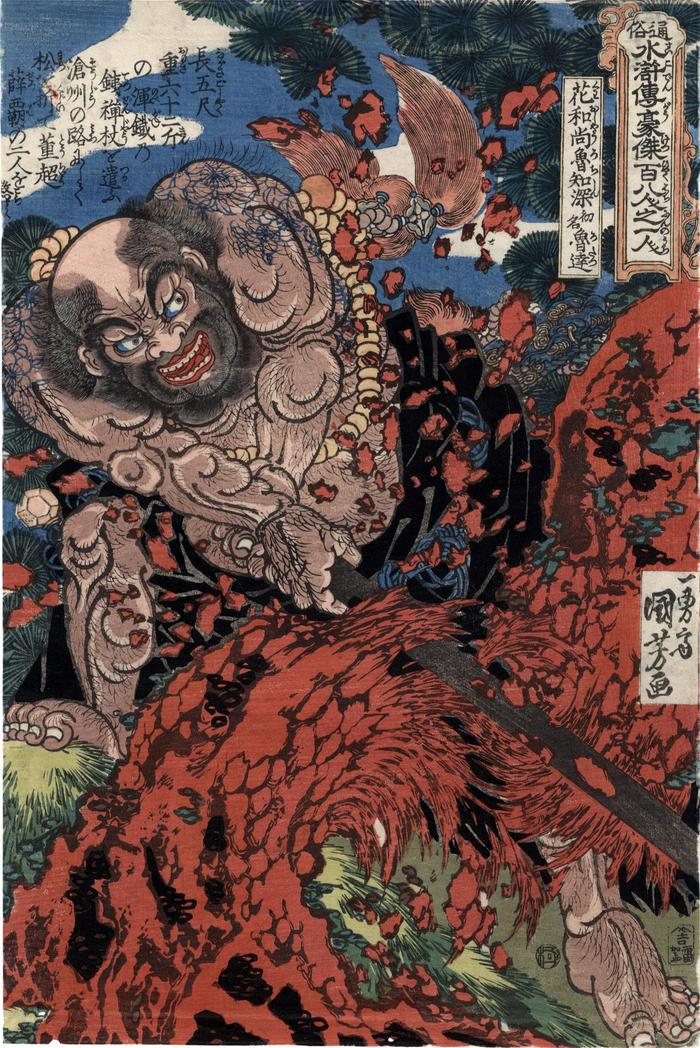Utagawa Kuniyoshi (歌川国芳) (artist 11/15/1797 – 03/05/1861)
Lu Zhishen, the Tattooed Monk - (Kaoshō Rochishin shomei Rotatsu - 花和尚魯知深初名魯達) from the series One Hundred and Eight Heroes of the Popular Shuihuzhuan (Tsūzoku Suikoden gōketsu hyakuhachinin no hitori - 通俗水滸伝豪傑百八人之一個)
ca 1827 – 1829
10 in x 14.75 in (Overall dimensions) Japanese color woodblock print
Signed: Ichiyūsai Kuniyoshi ga
一勇斎国芳画
Publisher: Kagaya Kichiemon
(Marks 195 - seal 22-025)
Censor's seal: kiwame
Museum of Fine Arts, Boston
British Museum
Hagi Uragami Museum of Art
Tokyo National Museum
Lyon Collection - Yoshiharu print of this heroic figure
Lyon Collection - Shi Jin, the Nine Dragons print
Rijksmuseum
Royal Museums of Art and History, Belgium (via Cultural Japan)
Art Institute of Chicago
Nationaal Museum van Wereldculturen (Rijksmuseum Volkenkunde, Leiden) via Ritsumeikan University
Chazen Museum of Art Lu Da, the original name of Lu Zhishen, first appears in Chapter 3 (p. 46) of the Outlaws of the Marsh. Shi Jin, Nine Dragons, - see Lyon Collection #1306 - is in search of his arms master, when he entered a small tea-house to make inquiries. He is told that the major to the local command walked in:
While the waiter was talking, a big fellow who looked like an army officer strode in. His head was bound in a bandanna with figured swastikas, buckled in the back with twisted gold rings from Taiyuan. A raven-black plaited sash bound his parrot-green warrior's gown at the waist. On his feet were yellow boots embossed with four welts of brown leather in hawk talon design. He had large ears, a straight nose and a broad mouth. A full beard framed his round face. He was six feet tall and had a girth of ten spans.(*****)
When the new-comer had taken a seat, the waiter said to Shi Jin: "That's the major. You can ask him about Wang Jin. He knows all the arms instructors."
Shi Jin rose quickly and bowed. "May I invite you to some tea, sir? Please join me."
The officer saw that Shi Jin was a big stalwart fellow who seemed a man of valor. He walked over and returned his greeting. Then the two sat down together.
"May I be so bold as to ask your name, sir?" Shi Jin queeried.
"I'm called Lu Da. I'm a major in this garrison. And who are you brother?
In Chapter 8 Kaoshō Rochishin comes upon two corrupt guards and is intent on intimidating them. He threatens to separate their heads from their bodies. To prove that he can do this "[Kaoshō Rochishin] lifted up his staff and struck a pine tree a blow two inches deep, and the tree fell cleanly over, unsplintered. He shouted, 'You two accursed, if you have evil plans in your hearts your head shall be cut off like this tree!' "
Quoted from: All Men are Brothers by Pearl Buck, p. 85.
****
Scholten Japanese Art wrote:
Rochishin (Lu Chi Shen in Chinese) is an anti-hero from the Suikoden (Tales of the Water Margin), a 16th century collection of stories considered to be one of the classics of Chinese literature. Rochishin, the tattooed subject of the lower sheet, is an outlaw. He was once a police officer named Rotatsu. In that capacity he killed a butcher who had abused his (the butcher's) mistress. The mistress' father advised Rotatsu to take the monk's name Rochishin and retire to the monastery on Mount Godai. Once on the mountain, he became widely feared for robbing merchants and drinking heavily, the latter of which activities was often followed by vomiting and urinating in the temple. After taking time to gather their courage, the monks forced him out of the monastery, at which point Rochishin joined a gang of thieves.****
Perhaps unsurprisingly, the life of a robber suited him well. He soon returned to the Mount Godai monastery when a rival gang found refuge within the temple walls. In this composition, Yoshitoshi depicts him by the monastery's entrance fiercely dismantling its sacred Nio (Buddhist guardian statue, also called Kongo). The drunken outlaw, whose determination is evident by his gritted face and athletic posture, holds firm beneath a heavy beam and falling green posts. The teetering Nio threatens him from above.
The Flower Priest
Rochishin was often referred to as the Flower (or Floral) Priest. The best manifestation of this is the tattoo of cherry blossoms on his upper torso and arms. Originally, in some earlier prints, it was often prunus blossoms, the first harbinger of spring. Later for various reasons it was changed to cherry blossoms.
****
Illustrated in:
1) In color in 歌川国芳展: 生誕200年記念 Utagawa Kuniyoshi: Exhibition to Commemorate the 200th Anniversary of his birth, 1996, #22, p. 48.
2) In color in Kuniyoshi by Juzo Suzuki, Heibonsha Limited, Publishers, 1992, no. 80.
3) In color in Of Brigands and Bravery by Inge Klompmakers, Hotei Publishing, 1998, p. 53, no. 6. The text is from page 52.
4) In color in Japanese Prints : Ukiyo-e in Edo, 1700-1900 by Ellis Tinios, Lund Humphries, 2010, p. 108. The author wrote: "In addition to drawing upon earlier prints, Kuniyoshi also had recourse to book illustrations for inspiration when designing warrior prints. In his first successful series in the genre, One of the 108 heroes of the popular Tales of the Water Margin he drew extensively on Hokusai's illustrations for a Japanese edition of the Chinese novel Tales of the Water Margin. Kuniyoshi's borrowings do not in any way diminish his accomplishment. He used his sources to create new and vibrant images in the print medium which proved immensely popular."
5) In color in Aziatische Kunst, 'Prenten' by Menno Fitski, vol. 37, issue 2, Brill, July 2007, no. 14, p. 24.
6) In a full page black and white reproduction in Kuniyoshi by B. W. Robinson, London, Her Majesty's Stationery Office, 1961, #8. Robinson gives the date of 1827.
****
The text reads: 長五尺重六十二斤の渾鉄の鉄禅杖を遣ふ 滄州の路にして松を折て董超薛覇の二人を懲す
Kagaya Kichiemon (加賀屋吉右衛門) (publisher)
Suikoden (水滸傳) (genre)
Tattoo (genre)
